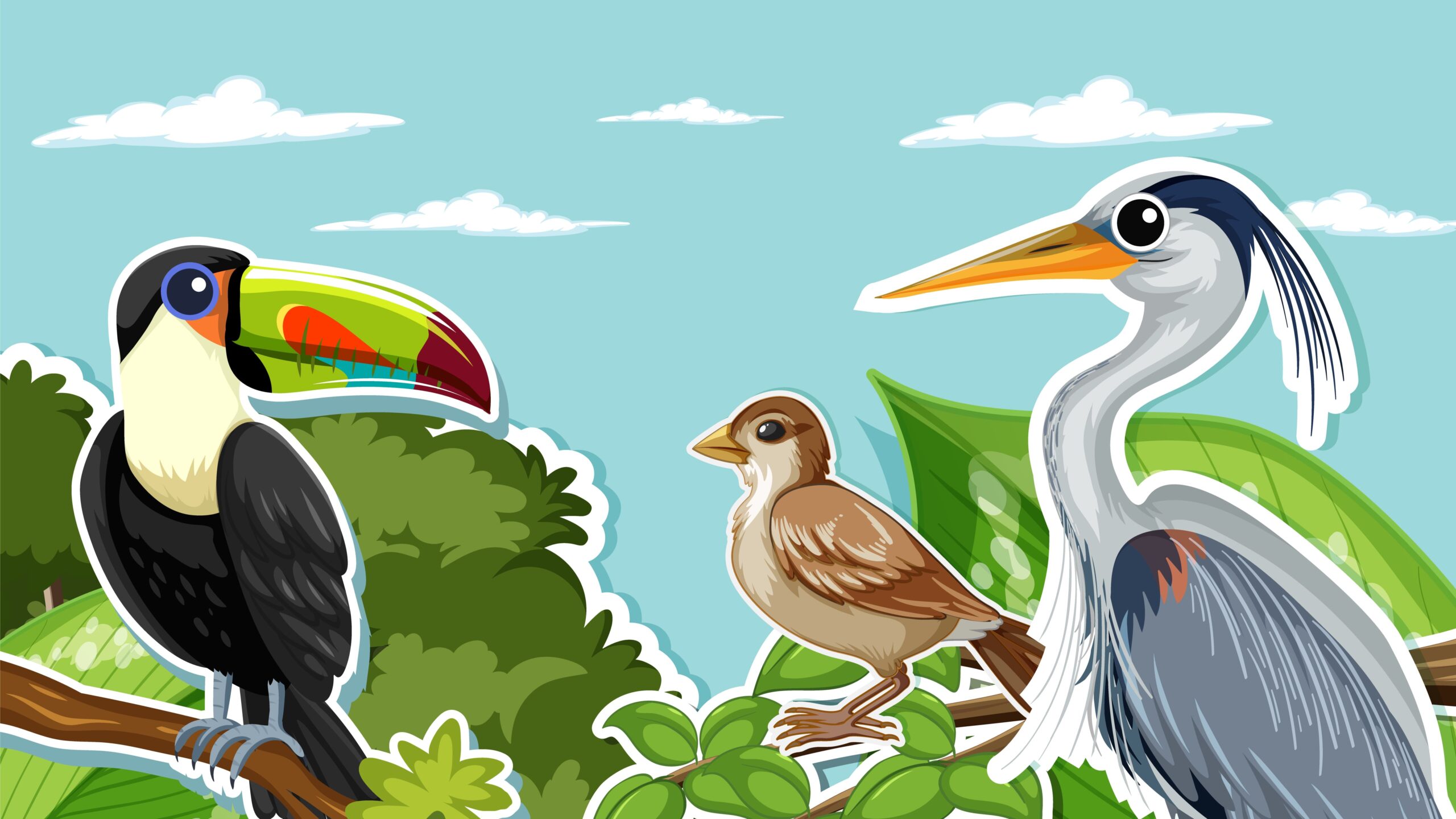Have you ever seen a bill quite like the one of a shoebill?
The shoebill is a large, ancient-looking bird found in East Africa’s marshes, known for its striking beak and silent hunting style. Nicknamed the “king of the marshes,” it has gained attention both in the wild and online for its prehistoric appearance and fierce presence.
The shoebill, aptly named after its signature feature, stands out with its enormous, clog-like bill that stretches up to a foot long. This powerful bill isn’t just for show—it’s the third longest of any living bird and is designed for a precise, deadly purpose. I
ts sharp edges and hooked tip allow the shoebill to snatch, grip, and kill live prey, making it one of the most skilled predators in the wetland.
Known for its stoic patience, the shoebill can remain motionless for hours, patiently awaiting its next meal. Once prey is in sight, it strikes with deadly accuracy, often taking down larger fish, frogs, water snakes, and even baby crocodiles.
A solitary, mostly sedentary bird, the shoebill leads a quiet, territorial life, spending its days hunting and nesting in solitude. But despite its calm demeanor, this bird has a call that will send chills down your spine, made by clattering its massive bill together.
At first glance, the shoebill doesn’t look real. With its towering height, steely stare, and a massive, clog-shaped bill, this prehistoric-looking bird feels like it wandered off the set of a fantasy movie. But the shoebill (Balaeniceps rex) is very real—and incredibly fascinating.
What Is a Shoebill?
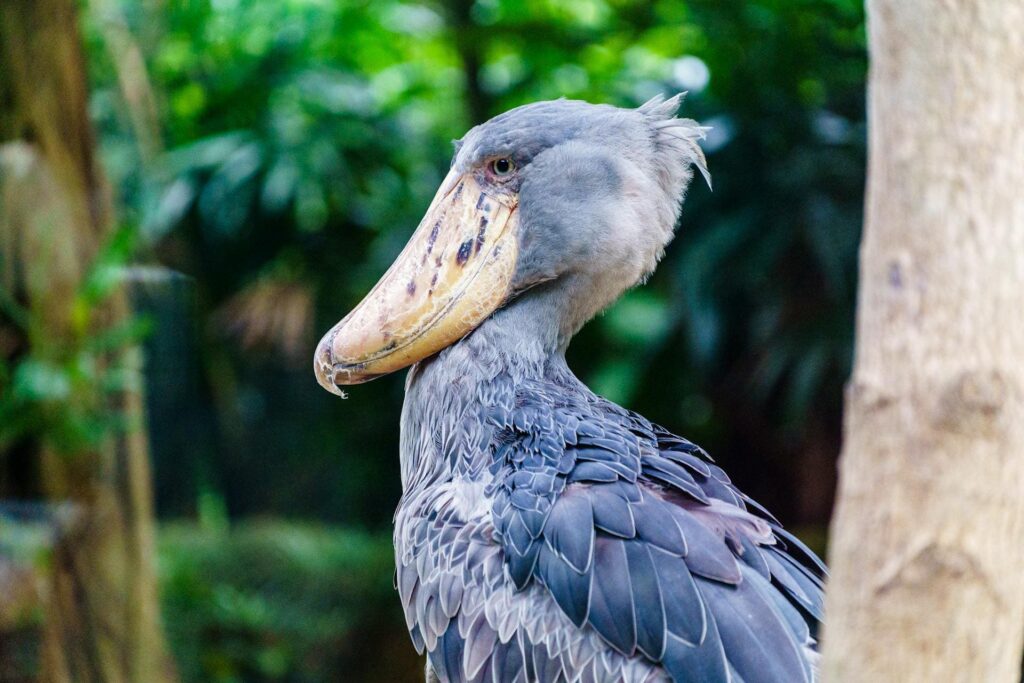
Also known as the whale-headed stork or simply “B. rex,” the shoebill is a rare, large wading bird found in the dense freshwater swamps of East and Central Africa. It gets its name from its enormous, shoe-shaped bill, which it uses to hunt aquatic prey like lungfish and baby crocodiles.
Though its massive beak and long legs resemble those of a stork, the shoebill is actually more closely related to pelicans and herons, according to genetic studies. It stands as the only member of its family, Balaenicipitidae, and is classified under the order Pelecaniformes.
Origins and Taxonomy
The shoebill may have been known to the ancient Egyptians, but it wasn’t officially described until the 19th century. British naturalist John Gould gave it the scientific name Balaeniceps rex in 1850 after examining a specimen from the White Nile. The name combines Latin terms meaning “whale” (balaena) and “head” (caput), a nod to the bird’s bulky beak.
Initially lumped in with storks, later evidence—including eggshell structure, anatomy, and DNA—confirmed its closer ties to pelicans and herons. In fact, the shoebill’s closest living relative is the hamerkop, another unusual bird native to Africa.
Physical Features: Nature’s Oddball
Shoebills are massive birds. Adults range in height from 110 to 152 cm (43 to 60 inches) and can have wingspans exceeding 2.5 meters (8 feet). Males weigh about 5.6 kg (12 lbs) on average, while females are slightly smaller.
But the showstopper is the bill: up to 24 cm (9.4 inches) long and among the largest in the bird world. This powerful tool is built for ambush hunting. With its sharp edges and strong hook at the tip, it can snap up wriggling fish and other slippery prey with ease.
Their plumage is a slate-grey with darker feathers on the wings, giving them a ghostly elegance. Juveniles are browner and smaller but quickly grow into their dinosaur-like appearance.
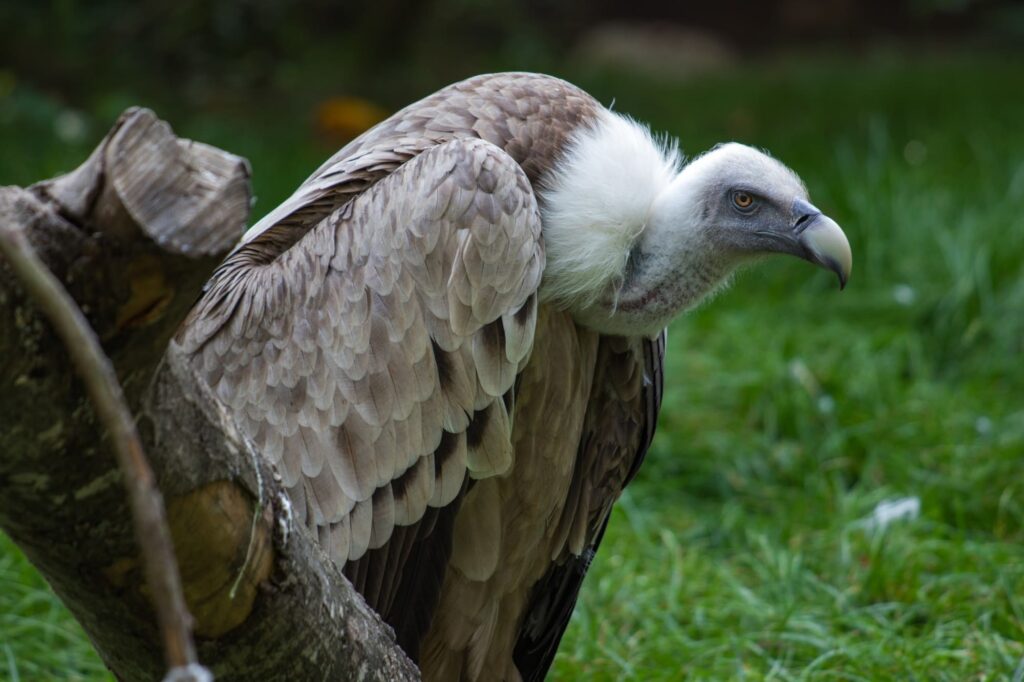
Behavior and Hunting Style
Nicknamed “the statue bird,” the shoebill is famous for standing motionless for hours, waiting for the perfect moment to strike. It favors oxygen-poor wetlands, where fish like lungfish must surface frequently to breathe—making them easy targets.
Shoebills don’t wade in open water like herons. Instead, they perch on floating vegetation and sneak up on their prey. A hunting strike is sudden, loud, and violent, often scattering water and plants in all directions. While 60% of their strikes are successful, they may spend several minutes wrestling larger prey into submission.
Interestingly, hippos help their cause: by disturbing the water, they flush out fish for the shoebill to catch.
Vocalizations and Communication
For such a silent bird, the shoebill has some unexpected vocal talents. While mostly quiet, it clacks its bill loudly, especially during nesting season. Adults may also let out low moos or high-pitched whines. Chicks, when begging for food, make sounds that eerily resemble human hiccups.
Flight and Movement
Despite their size, shoebills can fly. But they do so sparingly and not very far—typically no more than 100 to 500 meters at a time. Their slow, powerful wingbeats—only around 150 flaps per minute—make them resemble a gliding shadow more than a flapping bird.
In flight, they tuck in their necks like herons and storks. Long-distance migration is rare, though they may move locally depending on flooding or drought.
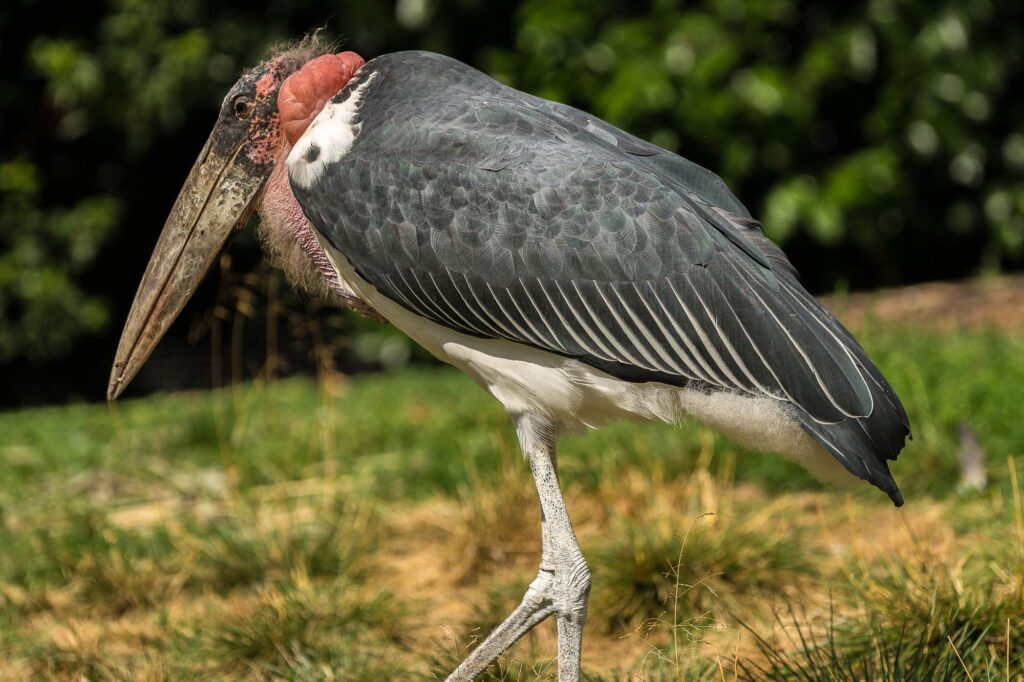
Habitat and Range
Shoebills inhabit remote, swampy areas across South Sudan, Uganda, Rwanda, Tanzania, Zambia, and parts of the Democratic Republic of Congo. The Sudd wetland in South Sudan is a stronghold, and Uganda is also a key country for shoebill populations.
They prefer dense marshes with a mix of papyrus, reeds, and other floating vegetation. They avoid pure papyrus swamps and are rarely seen near human activity. While primarily non-migratory, they may move in response to water level changes, especially during breeding season.
Breeding and Parenting
Shoebills are solitary, even during breeding. A pair will fiercely guard a territory up to 4 km² (1.5 square miles). They build floating nests of reeds and grasses, clearing a 3-meter-wide area before laying 1 to 3 eggs.
Notably, only one chick typically survives. The stronger chick may outcompete or even kill its sibling, a strategy seen in many raptors. Both parents incubate the eggs and care for the young, which take 3 to 4 months to fledge.

Diet: A Ruthless Gourmet of the Swamp
Shoebills are primarily piscivorous, meaning fish make up the bulk of their diet—but don’t be fooled into thinking they’re picky. These birds are opportunistic predators with a taste for a variety of wetland creatures.
Favorite Fish Dishes
The shoebill’s signature menu includes:
- African lungfish (Protopterus annectens)
- Marbled lungfish (Protopterus aethiopicus)
- Senegal bichir (Polypterus senegalus)
- Catfish, especially of the Clarias genus
- Tilapia species
In Zambia’s Bangweulu Swamps, the average catch ranges from 15 to 50 cm (6 to 20 inches) in length, but the shoebill doesn’t shy away from big game. In Tanzania’s Malagarasi wetlands, they’ve been seen wrestling with fish up to 99 cm (3.2 feet) long.
When tackling oversized prey, shoebills use their sharp-edged beaks and powerful neck muscles to cut the catch into more manageable chunks, swallowing it piece by piece over several minutes. It’s a slow, methodical process that can take anywhere from 2 to 30 minutes, depending on the prey’s size and slipperiness.
Beyond Fish: A Swamp Buffet
While fish are the main course, shoebills also dine on:
- Water snakes (commonly 50–60 cm long)
- Nile monitors (Varanus niloticus)
- Frogs and toads
- Baby crocodiles
- Small turtles
- Rodents
- Small waterfowl
- Snails and carrion (on rare occasions)
Their massive bill and wide gape let them tackle prey much larger than most other wading birds can manage.
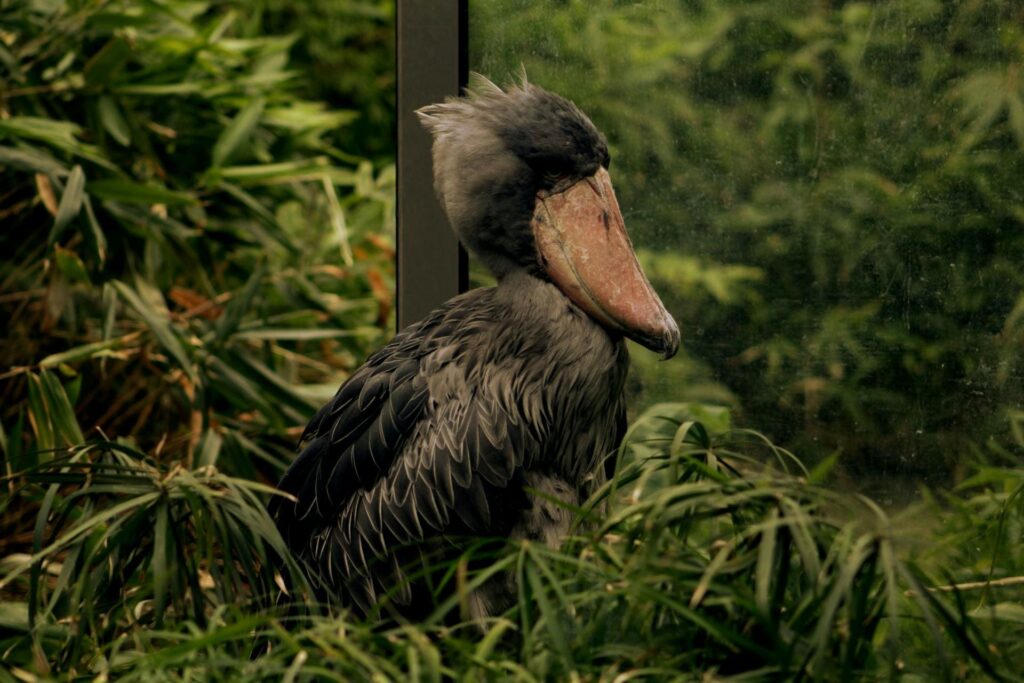
Feeding the Next Generation
Shoebill parents are careful providers. In Uganda and Zambia, chicks are often fed lungfish, catfish, and water snakes, with the food size adjusted to the chick’s age and swallowing ability.
But mealtime in the swamp isn’t always peaceful. African fish eagles (Icthyophaga vocifer) are notorious for stealing large prey from shoebills—especially when the meal is too heavy to swallow quickly.
Appearances in Popular Culture
Once a hidden gem of the avian world, the shoebill has soared into internet stardom. Beginning around 2014, this prehistoric-looking bird captured the collective curiosity of the web, largely thanks to its haunting stare and statuesque stillness. One viral video showed a shoebill standing motionless in the rain, eyes locked onto the camera like a living animatronic—a moment that quickly morphed into meme gold.
From then on, the shoebill’s meme career only grew. Its unnerving calm and intense gaze made it a perfect symbol for stoicism, awkward tension, and silent judgment. TikTok, always hungry for strange and expressive creatures, picked up the shoebill and ran with it—cementing its status as an internet icon and introducing millions to a bird they never knew existed.
But the shoebill’s influence isn’t just limited to memes. Gamers might recognize a hint of its unique silhouette in the Loftwings, the large, noble birds that carry heroes across the skies in The Legend of Zelda: Skyward Sword (2011). According to developers, the shoebill served as inspiration for these fantastical creatures, blending real-world awe with digital adventure.
From swamps to screens, the shoebill has become more than just a fascinating predator—it’s now a pop culture phenomenon.
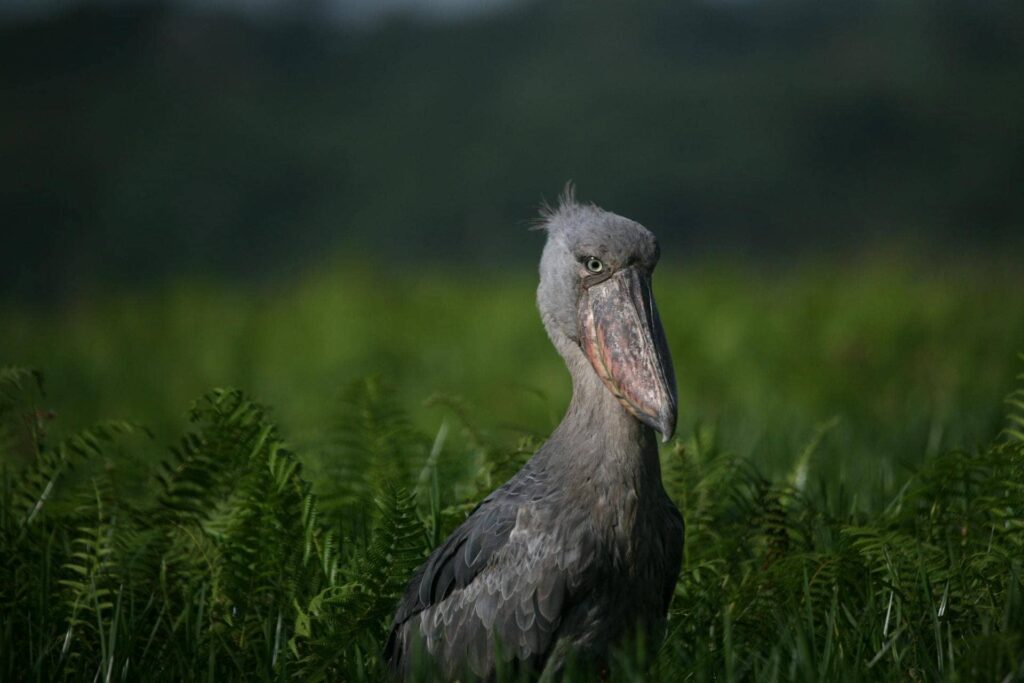
Conservation Status
The shoebill is classified as Vulnerable by the IUCN and listed under CITES Appendix II, meaning it’s at risk but not yet endangered. Its global population is estimated at 5,000 to 8,000 individuals, though exact numbers are hard to confirm due to their remote habitats.
Threats include:
- Habitat destruction (especially wetland drainage for agriculture)
- Disturbance by humans
- Nest raiding
- Capture for the illegal pet trade
Did you know?
Shoebill Stork Plush: Why Everyone Wants One
From eerie internet memes to viral TikToks, the shoebill stork has become a cultural icon. Its unique appearance—especially its massive, clog-shaped bill—has inspired a wave of plush toys that fly off the shelves. Shoebill plushies are now fan favorites among bird lovers and collectors for their charming oddity and rarity in the toy world.
The Eerie Shoebill Stork Sound
If you ever hear a loud, machine gun-like rattling sound in a swamp, you may be near a shoebill stork. Instead of typical bird calls, shoebills make a distinctive bill-clattering sound by rapidly snapping their beaks together. This sound, especially during nesting or when greeting another bird, adds to the shoebill’s intimidating aura.
Shoebill Stork Location: Where Do They Live?
Shoebills are native to the tropical wetlands of central Africa. You can find them in countries like Uganda, Zambia, South Sudan, and parts of the Congo. They prefer dense marshes, floodplains, and swamps—places where they can stand motionless for hours, waiting to ambush prey.
Can a Shoebill Stork Kill You?
While shoebills look terrifying with their powerful beaks and intense stare, they pose little danger to humans. They’re solitary and shy by nature. Although they can take down large prey like lungfish or baby crocodiles, there’s no evidence of shoebills attacking people. So, no—they can’t kill you, but they sure can scare you.
Shoebill Stork Height and Size
Shoebills are giants among birds. They can grow up to 5 feet (1.5 meters) tall, with wingspans reaching 7 to 8 feet (2.1 to 2.4 meters). Weighing between 10 to 15 pounds (4.5 to 7 kg), their size and dinosaur-like presence make them one of the most awe-inspiring birds in the animal kingdom.
Shoebill Stork Diet: What They Eat in the Wild
These birds are carnivorous hunters with a taste for the dramatic. Their diet primarily includes lungfish, catfish, and bichirs. But they also eat frogs, eels, young crocodiles, turtles, and even small mammals and birds. With a 60% strike success rate, they’re among the deadliest ambush predators in the bird world.
Do Shoebill Storks Fly?
Despite their size, shoebills are capable fliers. They can fly short distances and use strong, slow wingbeats to glide over wetlands. They usually fly alone and only when necessary, preferring to walk or stand for long periods instead.
Shoebill Predators: What Threatens This Bird?
Adult shoebills have few natural predators, but eggs and chicks can fall prey to monitor lizards, snakes, and birds of prey. Human activity—like habitat destruction and illegal poaching—is the greatest threat to their survival today.
Shoebill Lifespan: How Long Do They Live?
Shoebills can live for 35 years or more in captivity and around 30 years in the wild. Their long lifespan, combined with slow reproduction rates, makes conservation efforts all the more critical.
Shoebill Stork Next to a Person: Just How Big Are They?
Seeing a shoebill beside a human puts their massive size into perspective. They often stand eye-to-eye with people and can tower over children. Photos and videos of shoebills next to zookeepers or researchers highlight just how prehistoric and powerful they look.
How Tall Is a Shoebill Stork, Really?
At full height, shoebills can reach 4 to 5 feet tall. Combine that with their long legs and enormous bill, and you’ve got a bird that looks like it stepped out of the Jurassic era. Their towering presence is one reason they’ve captured the world’s imagination.
Final Thoughts: A Bird Worth Protecting
With its mysterious stare, statuesque stillness, and bizarre bill, the shoebill is one of the world’s most distinctive birds. It’s a living relic of a wilder Africa—one that still holds secrets in its swamps and rivers.
Protecting the shoebill means protecting its habitat, and by doing that, we also protect countless other species that share its fragile world. Whether you’re a birdwatcher, a conservationist, or just curious about nature’s weirdest wonders, the shoebill is a bird that demands attention—and deserves our respect.

